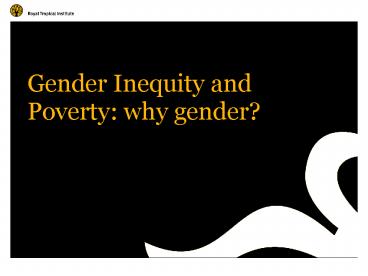Gender Inequity and Poverty: why gender - PowerPoint PPT Presentation
1 / 10
Title:
Gender Inequity and Poverty: why gender
Description:
girls still accounted for 57 percent of the out-of-school children of primary ... for more than 60 percent in the Arab States and in South and West Asia (UNESCO 2005) ... – PowerPoint PPT presentation
Number of Views:66
Avg rating:3.0/5.0
Title: Gender Inequity and Poverty: why gender
1
Gender Inequity and Poverty why gender?
2
International consensus on development
- Reduce and eliminate poverty
- Stop preventable disease, promote health for all
- Build capacities across the population support
universal literacy and education - Sustainable environment/resources
3
What has gender got to do with development?
- Poverty
- Health
- Education
4
Poverty
- Disaggregation of the poor
- Across the world, women and children represent a
disproportionate percentage of the worlds poor. - Feminization of poverty
- growing phenomenon
- refers to the large and increasing proportions of
women in agriculture, casual wage labour and
unpaid labour - Assetlessness
- Fewer women than men own assets necessary to earn
a living or to offer collaterals to get loans.
5
Gender differences and poverty
- Gender intersects with economic deprivation to
produce more intensified forms of poverty for
women than men poor women are disadvantaged by
being women as well as by being poor and the
effects of poverty are therefore worse. - Gender makes poverty harder to escape since women
face gender bias in markets, barriers to labour
market entry and poor access to productive
resources including information. - Womens experience of poverty is different to
that of men, for example women might experience
time poverty as a particularly acute aspect of
their deprivation. - Gender makes women vulnerable to certain
processes of poverty which do not apply to men,
for instance, poverty resulting from marital
breakdown, death of a spouse, or social exclusion
resulting from sexual behaviour considered
inappropriate.
6
Why women are poorer than men
- Time poverty and reduced mobility due to unpaid
work and responsibilities for domestic tasks and
care of the household members - Biases in labour markets producing low returns to
labour - Lack of access to resources such as credit,
property and education, the latter in particular
reinforcing womens low returns to labour - Lack of control over earned income producing
disadvantage within households - Limitations on access to public space producing
restrictions in access to labour markets,
restrictions on mobility limitations on
legitimacy in spaces where resource distribution
is negotiated and limited access to information.
7
Health
- Half a million women die and eight million women
are disabled annually from pregnancy related
causes (WHO et al 2000). - Maternal mortality ratios (maternal deaths per
100 000 live births) in 2000 standing at 830 in
Africa and 330 in Asia - In Africa and Asia over 40 percent of births are
not attended by skilled health professionals
trained in pregnancy, childbirth and the
immediate post-natal period. - About 25 percent of children are born with low
birth weight due to the health problems suffered
by the mother during pregnancy leading to long
term poor health
8
Education
- the number of out-of-school children is declining
- But
- girls still accounted for 57 percent of the
out-of-school children of primary school age of
primary school age worldwide in 2001 and for more
than 60 percent in the Arab States and in South
and West Asia (UNESCO 2005). - amongst 83 developing countries with available
data, only 16 have gender parity in enrolment at
secondary level, and only four at tertiary level
(UNESCO 2005) - In 2002, about 800 million adults in the world
were illiterate, most of them in sub-Saharan
Africa and East and South Asia. Of them, 64
percent are women.
9
Why should NGOs address gender?
- Global gender gaps
- Lessons learned in development objectives of
poverty reduction, better health and universal
basic education cannot be achieved without
addressing gender inequities - Gender inequity and poverty are inextricably
linked and mutually reinforcing
10
So what is gender?
- Gender is the social definition of what it is to
be a man or woman in a given society. - Gender refers to the rules, norms, customs and
practices through which the biological
differences between males and females is
transformed into social differences between men
and women, boys and girls. - This process results in girls/women and men/boys
being valued differently, having unequal life
chances and opportunities































